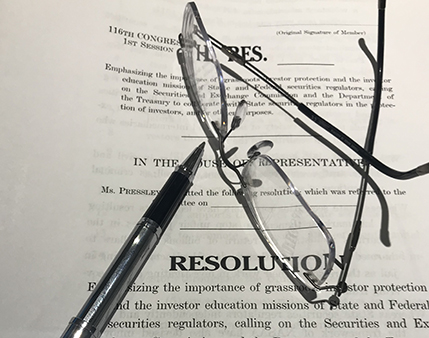Written Statement of the North American Securities Administrators Association
To Be Included in the
Hearing Record of The Subcommittee on Oversight and Investigations
and the
Subcommittee on Financial Institutions and Consumer Credit Hearing,
Committee on Financial Services
March 6, 2001
The North American Securities Administrators Association* is pleased to present its views on efforts to coordinate federal and state programs to fight financial fraud against consumers. State and federal securities regulators have developed an efficient and costeffective mechanism for centralizing the licensing and disciplinary histories of brokerdealers, broker-dealer agents, investment advisers and investment adviser representatives. NASAA supports Congressional efforts to create a network amongst federal and state functional regulators to coordinate certain enforcement information.
The complementary structure of state, federal and industry regulation of the securities markets has a proven record of serving investors well over the past 60-plus years. State securities regulators play a unique role in protecting investors through enforcement programs, investment adviser and broker-dealer regulation, review of financial offerings of small companies, and investor education initiatives. State securities regulators work on the front lines, recognizing potentially fraudulent activity and alerting the public to beware of scams. Because they are closest to the investing public, state securities regulators identify new investment scams quickly and bring enforcement actions covering a wide variety of investment-related violations. They also work closely with criminal prosecutors at the federal, state and local levels to punish securities law violators.
NASAA’s members handle the majority of individual investor complaints and are often in a more advantageous position to observe the impact of regulatory policies on investors. The role of state securities regulators has become increasingly important as Americans have turned to the financial markets to prepare for their financial futures. We are today indeed a “nation of investors.” Over half of all American households — and 70 percent of voters — are now investing in the securities market.
Since 1998, state securities enforcement activity has focused on several areas including:
Day Trading – After uncovering questionable practices at day trading firms beginning in 1998, Colorado, Massachusetts, Wisconsin, Indiana, Maryland and Texas took actions and imposed restrictions on firms in their states. Since then, the National Association of Securities Dealers Regulation (NASDR) proposed rules to the SEC relating to the opening of day trading accounts.
Boiler Room Scams – Long before the movie Boiler Room, NASAA published a 1997 Investor Alert warning the public about investment fraud promoted over the telephone. In 1998, NASAA coordinated a nationwide enforcement “sweep” that included 106 actions against 75 firms in 29 states.
Joint Promissory Note Enforcement Sweep – Last year, state securities regulators and the Securities and Exchange Commission (SEC) announced a joint effort to combat the fraudulent sale of promissory notes to investors. Although they can be legitimate investment vehicles, promissory notes have increasingly been used as a vehicle to defraud investors. Securities regulators in 28 states filed scores of actions against hundreds of individuals and entities for selling bogus promissory notes. The SEC filed enforcement actions against 38 individuals and 22 entities involved in the fraudulent sale of promissory notes.
Viatical Scams – Viatical contracts are interests in the death benefits of terminally ill patients. Because of uncertainties in predicting when a terminally ill person is going to die, these investments are extremely speculative and often inappropriate for small investors. State securities regulators and law enforcement officials recently observed a disturbing increase in the number of scam artists who have entered the viatical industry with the intent of fleecing investors. As a result, they have heightened regulatory scrutiny over and filed numerous enforcement actions against parties selling investments in viatical settlement contracts.
Payphones – Securities regulators in 17 states are concluding a sweep targeting questionable payphone investments. So far, investigators have identified over 4,200 individuals that stand to lose $75 million; total losses are likely to be in the hundreds of millions of dollars. In a typical scheme, a company, through a middleman, sells pay phones to investors for between $5,000 and $7,000. As part of the sale, the company agrees to lease back and service the phones. Investors are promised annual returns of up to 15 percent. Of particular concern to state regulators is the role of insurance agents in the sale and distribution of risky, questionable or fraudulent securities. In addition to payphones, a variety of other high-risk investments, such as ATMs, viaticals, and promissory notes, are being sold by independent insurance agents.
Callable CDs – Some stockbrokers are pushing elderly investors to buy higher yielding “callable” certificates of deposit with 10- to 20 -year maturities. Rising interest rates and the falling stock market have made CDs more attractive, especially to investors who rely on interest income. But what many investors don’t realize – and some stockbrokers apparently aren’t adequately disclosing – is that with “callable” CDs only the issuer, and not the investor, can “call” or redeem the CD. Investors who want their money before a “callable” CD matures risk a substantial loss.
As you can see from the above examples, fraudsters are creative and resourceful, and often move from one vulnerable set of victims to another and even from one industry to another. NASAA supports the effort to create an anti-fraud network to assist regulators in detecting patterns of fraud and coordinating efforts amongst functional regulators.
To coordinate enforcement actions, state securities regulators meet with their SEC and NASDR counterparts at an annual NASAA-sponsored enforcement conference, at its Spring Public Policy Conference and during many informal meetings throughout the year. Perhaps NASAA’s and NASDR’s most important collaborative effort was their joint development of the Central Registration Depository (CRD): the electronic filing and tracking system for all entities that regulate broker-dealers and their representatives.
CRD Background
State securities regulators, NASD and the SEC realized that it was inefficient for each regulator to have their own filing systems to license broker-dealers and their agents. Not only was it burdensome for the regulated community, but the information was hidden away in one regulator’s filing system; other regulators had little or no access to the often important information. In 1980, the NASD and the states through NASAA, agreed to jointly develop a system that would collect information to be stored in a single place, the CRD, and be available to all securities regulators. State securities regulators also make CRD reports available to the general public and other regulators upon request. After NASAA and the NASD launched the CRD in 1981, a “rogue” stockbroker could no longer go from state to state and hope that the jurisdictions did not communicate with one another — all the disciplinary information on that individual is stored in a central place and easily accessible to state regulators, the NASD and the SEC. Perhaps more importantly, by using the CRD, a state securities agency protects investors from fraudulent activity by refusing to grant a securities license to a fraudster who is trying to sell securities to residents of that state. Making the CRD information available to the public and urging customers to check the CRD before investing with a broker is a cornerstone of NASAA’s investor education program.
NASAA and the NASD have worked diligently to take advantage of technological advances to improve CRD as a licensing and enforcement tool. In 1999, for instance, NASAA and the NASD as joint owners, launched Web CRD, a thoroughly redesigned system that gives regulators the ability to keep even closer track of problematic firms and individuals. Thanks to Web CRD, a regulator can access this licensing and disciplinary information from anywhere in real time. For example, a state securities regulator performing an exam on a broker-dealer in Kansas can use a laptop to log onto Web CRD and discover an action taken against that broker-dealer by the NASD that same morning.
Web CRD also allows regulators to proactively search the database and generate reports highlighting bad brokers and troubling trends. The CRD system contains records on more than 650,000 individuals and over 6,000 firms. Disciplinary information is captured from a number of sources, including state securities regulators, the SEC, the NASD, the NYSE and AMEX, from FBI rap sheets returned from fingerprint submissions, as well as from individual registrants and the brokerage firms.
IARD Background
Another successful cooperative effort between state and federal regulators is the Investment Adviser Registration Depository (IARD). The National Securities Markets Improvement Act of 1996 (NSMIA) divided regulation of investment advisers between the states and the SEC depending on the amount of the firm’s assets under management. The number of investment advisers has grown exponentially over the last ten years and now approaches 25,000 firms and approximately 125,000 investment adviser representatives.
The SEC and NASAA chose NASD Regulation as the vendor to build and operate IARD and to integrate it to the extent possible with Web CRD. IARD is modeled on Web CRD and provides for the centralized electronic filing of registration applications, amendments and renewals. Like Web CRD, IARD will allow securities regulators nationwide access to disciplinary information and utilize similar functionality.
Antifraud Database Across Regulator Lines
As detailed above, NASAA has used and developed Web CRD and IARD to license registrants and to combat fraud. These systems were designed for and have been effective in allowing securities regulators to share information about individuals and entities they regulate.
Now, with the advent of the Gramm-Leach-Bliley Act and the ingenuity of those who commit fraud, NASAA believes it is critical that information among financial regulators be shared in order that those who migrate from industry to industry can be effectively tracked.
NASAA has extensive experience developing a comprehensive electronic system to deliver enhanced regulatory oversight and enforcement with the ultimate goal of protecting investors. Our members look forward to working closely with you as your proposal takes shape. There are many questions to be asked and answered during the development phase of a network to be accessed by a number of different entities. They include:
- What regulatory enforcement databases currently exist?
- What information is captured in each database?
- Who has access to this information? Is it regulators only? Does the public have access to databases that currently exist?
- How can confidential regulatory information be protected?
- What information should be accessible and what types of information should not be released?
The vast majority of brokers and investment adviser representatives are honest, ethical professionals. It is the duty of state securities administrators to ensure that investors are doing business with reputable professionals. There are a relative handful of bad apples in the securities and investment adviser business but they can do a lot of harm to individual investors. These “rogue” operators often move from firm to firm, and from one industry to another, as complaints and disciplinary actions pile up against them.
State and federal securities regulators have developed an efficient and cost-effective mechanism for centralizing the licensing and disciplinary histories of broker-dealers, broker-dealer agents, investment advisers and investment adviser representatives. We support Congressional efforts to create a national information-sharing network among regulators to fight financial fraud. State securities regulators have a wealth of technical expertise and resources and welcome the opportunity to work with the Financial Services Committee as a system is developed to share enforcement information with state and federal regulators from the banking and insurance sectors.
Endnotes:
*The oldest international organization devoted to investor protection, the North American Securities Administrators Association, Inc., was organized in 1919. Its membership consists of the securities administrators in the 50 states, the District of Columbia, Canada, Mexico and Puerto Rico. NASAA is the voice of securities agencies responsible for grass-roots investor protection and efficient capital formation.
March 6, 2001











